
Having published a men's / high volume Performance Rock Shoe Group Test last year, it became apparent that there are now a lot of exciting women's / low volume offerings on the market too. It seems a good time for a group test. With outright 'performance' being a bit general, we asked for down-turned/stiff/supportive rock shoes designed predominantly for sport and bouldering, but that will work on the board and wall when the UK weather doesn't play ball.
What is performance?
As a truly subjective area, 'performance' is very much down to the individual - one person's warm up can be another person's lifetime achievement.
However, a benchmark has to be drawn somewhere, and as with the high volume / men's review we have drawn it at around Font/French 7A. That said, you are the one defining your performance, and if you are targeting a certain kind of climb, then we hope the descriptions below allow you to match your performance needs to the focus of a specific shoe.
Focus
The criteria for this review was something that is down-turned, supportive, and with a good edge. Aside from the fact that we LOVE edging, the reasoning behind this is that for 99% of British sport climbing an edge is what you'll be after - just look at Malham, the slate, LPT, or Portland. In bouldering the lines get a little blurrier, as you're not on your feet for quite so long and less likely to be on your toes and calves. Extrapolating down the shoe, a supportive forefoot and a supportive midsole prevent your feet getting tired while standing on small edges.
With so many highly specialist shoes out there, each for a very specific discipline/angle/gradient/style, a side by side comparison is pretty tough. We have therefore not awarded a best in test, but looked at, and marked, each shoe against set criteria and tried to give enough descriptive colour for you to pick up elements that might work for you.
Forefoot
Today's shoes might be getting softer and softer, but a lot of rock in the UK requires a good edge. Obviously the softer the shoe, the less supportive it is, so what this suggests is that a lot of rock shoe development hasn't actually been that appropriate for what we've got in the British Isles. Take Portland, the slate, Malham, or LPT as an example: each of these venues favours a rock shoe with a little more support over a shoe with a little bit of extra sensitivity. Obviously you need a blend of the two, but what we're saying is that to use an edge you need a bit of support. We have scored this review accordingly - a stiffer forefoot is a better forefoot.
Midsole
The flexibility of the midsole can have a huge effect on the type of climbing your shoe performs on. A stiff midsole is usually good for longer routes, giving support to your foot that adds stability and reduces calf pump. This can also be helpful when on the vertical when you have significant weight through your toes. A softer midsole can be advantageous for bouldering and shorter technical routes as the shoe can flex on steep terrain and enable easier toe hooking or smearing. Many of the shoes tested are somewhere in the middle, with a combination of stiffness and flex for all-round performance, though some are more specialist at one end of the scale. It is worth getting your hands on a pair in real life to see how much (and where) they flex.
To a certain extent the midsole also has a part to play in the shoe's edging capacity. However, you can get shoes with a stiff forefoot that can (as a result) have a good edge, but yet have a soft midsole - hence it's difficult to transfer the power fully throughout the rest of your foot. As such, if you've got a more supportive midsole you should theoretically be able to edge that little bit better - particularly if you've got quite weak toes.
Uppers
Uppers vary in composition. Some brands favour synthetic fabrics due to their low-stretch nature, which helps to maintain shape over the course of a shoe's lifespan. They also have the advantage of being vegan friendly. Others prefer natural fabrics such as suede, because it gives a little over time, becoming that bit more comfortable, and moulding to the user's foot. Each has downsides: synthetics don't breathe so get quite warm and can cultivate bacteria causing them to get smelly; suede and leather often have a longer breaking in period, can leach colour into your feet from the dyes used and, in some cases, give a little too much, eventually bagging out and losing performance as a result. Both synthetic and natural uppers can be either lined or unlined, with the former less likely to stretch so much.
We hace also looked at the rubber distribution on the uppers as well as the mechanism of closure. For the latter the group includes lace, single and double velcro straps as well as two patented closure systems.
Fit
Since performance shoes tend to rely on a snug fit, all but one of the shoes on test were sized down from street size by our testers. With a women's / low volume shoe, you should be able to assume a closer fit for a narrower and shallower foot, but there are still other variables. Asymmetric or straight? Pointed or rounded at the toe? What is the shape of the heel cup and the depth at the achilles? Lined or unlined, synthetic or natural upper? At the end of the day a shoe can't perform for you if it doesn't fit your foot. It also isn't necessarily the case that a narrow last or sole means a narrow fit - in some shoes with a narrow sole, the fit of the uppers will adapt to the shape of a wider foot.
As always, we strongly recommend trying multiple pairs before you buy (after all, with a price tag of at least £120 it's a serious investment!) and when you do find a pair that works, buy a lot of them!
Women's and Men's vs. Low Volume and High Volume
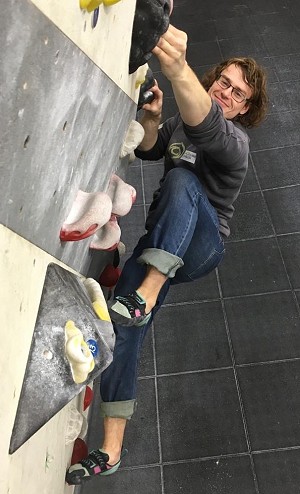
All in all we tested four "low volume" shoes and five "women's" shoes [well, four "women's" shoes and one "lady" shoe!!! - Ed].
Different brands have taken different approaches to this issue. Some prefer a narrower, lower volume option that is designed to be non-gendered and part of a continuum with the higher volume range. Others create a specifically women's shoe with (variously) a different rubber compound, flexion and last, on the premise that women are lighter, have smaller heels and need a bit more softness/play in the midsole. Needless to say, there is normally a skew towards a smaller size range in women's / low volume shoes.
In our view, shoes in this review should provide a valid option for lighter, smaller or lower volume/narrow-footed climbers, irrespective of gender, and pleasingly, many do. After all, a shoe that offers performance to you is likely to correlate with the one that best fits your foot!
Rubber
Rubber varies hugely across the shoes in this review. While 4mm is a "standard" thickness, thicker rubber can add durability and provide support while thinner rubber may allow greater sensitivity in feeling the features of the rock/hold. The rubber compound used also makes a big difference - as a sweeping generalisation a harder compound will be better at edging, whereas a softer compound will be better at smearing.
Overall Summary
|
Make and model |
Ratings | |
|
Scarpa Price: £120 Focus: Boulder/Sport/ Trad Profile/Fit: Low volume / Medium
|
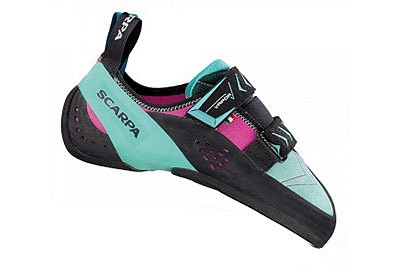
|
Stiffness/Support Edge
Sensitivity
Overall
|
|
Tenaya Price: £120 Focus: Boulder/Sport Profile/Fit: Low volume / Narrow
|
|
Stiffness/Support Edge
Sensitivity
Overall
|
|
Five Ten Price: £119.95 Focus: Profile/Fit: Low volume / Narrow
|
|
Stiffness/Support Edge
Sensitivity
Overall
|
|
Black Diamond Price: £120 Focus: Sport/Boulder Profile/Fit: Low volume/ Medium
|

|
Stiffness/Support Edge
Sensitivity
Overall
|
|
Red Chili Price: £130 Focus: Bouldering / Sport Profile/Fit: Medium volume / Medium
|
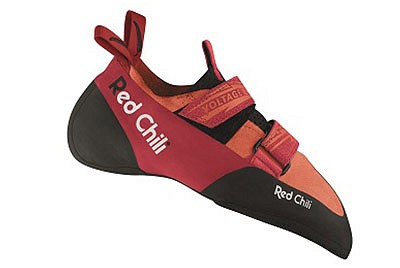
|
Stiffness/Support Edge
Sensitivity
Overall
|
|
Ocun Price: £120 Focus: Sport / Bouldering Profile/Fit: Low volume / Narrow-Medium |
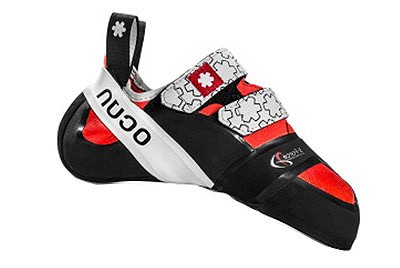
|
Stiffness/Support Edge
Sensitivity
Overall
|
|
La Sportiva Price: £145 Focus: Sport/Trad/ Bouldering Profile/Fit: Medium volume / Medium
|
|
Stiffness/Support Edge
Sensitivity
Overall
|
|
Boreal Price: £120 Focus: Sport/ Bouldering Profile/Fit: Low volume / Medium-Wide |
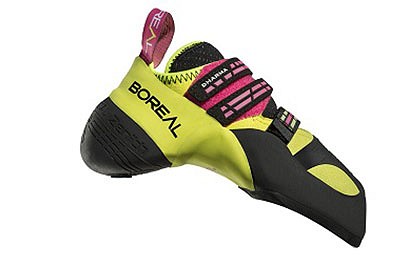
|
Stiffness/Support Edge
Sensitivity
Overall
|
|
Unparallel Price: £120 Focus: Profile/Fit: Low volume / Narrow |
|
Stiffness/Support Edge
Sensitivity
Overall
|
Scarpa Vapour V Women - £120
Recently redesigned, the women's Vapour V is a slightly asymmetrical, slightly downturned shoe that can balance sensitive smearing with refined toe power. It also has a very low volume heel. As a result this is an excellent all-round entry point into the downturned performance shoe market. Our tester was a complete convert within a couple of wears, though had issues with durability.

Forefoot
The Vapour Vs have a pronounced edge which builds as it gets further away from the toe. The outside edge starts relatively far back, on the side of the little toe (needs some thought but isn't a problem). Some stiffness, a slightly pointed toe and a medium downturn provide accuracy for little edges allowing you to apply pressure well once the shoes are broken in. The forefoot as a whole offers a good level of sensitivity - much to our tester's surprise (as a fan of flat shoes for smearing) they turned out to be great smearing shoes where you can get a large forefoot contact area when needed.
Midsole
Redesigned with a full length Talyn midsole and Bi-tension rand system, the Vapour V is intended to provide excellent support. Our tester found this a semi-soft shoe in the midsole, not offering as much support for longer, vertical sport routes where you may find your toes and calves doing a lot of the work! For bouldering the softness is helpful, giving plenty of flex for hooking and smearing - two strengths of this shoe. The high midfoot also supports the arch well and transfers power effectively to the toes.
Uppers
The microfibre uppers were comfortable and easy to wear in, and the shoe was breathable owing to a combination of a mesh tongue and side vents. The rubber comes up on top of the big toe which is very helpful for toe hooking, and, aside from the big toe, stops short of covering the toe knuckles keeping that area comfortable. The rubber above the big toe is also scored to allow flex.
Opposing velcro straps allow a good fit and the ability to ensure tightness where you want it, but sadly after a few weeks some of the Velcro fastening strap came away - only cosmetic detailing, but a slight worry on the build quality of the shoe.
Fit
The overall fit was slim, but not narrow, fitting an average-wider low volume foot well and providing comfort around the toes. This is also very much a shoe where you could change size for a more aggressive or relaxed fit and enjoy different benefits without compromised fit.
The heel cup is comparatively narrow and shallow offering a perfect fit and great hooking security compared to other shoes – well worth trying if you have suffered baggy heels in the past. The top of the heel did dig in a bit on the achilles [a problem also reported with the older models of the Vapour V – Ed] after a while, but whether this is a question of cut or the last shape driving power forwards, it's hard to tell. All in all, for our tester the heel shape was a game-changer: "Never before had my heel had such a snug fit, meaning I could actually really pull on heel hooks!"
Women's and Men's vs. Low Volume and High Volume
The women's Vapour V is designed on a women's-specific low volume FRW last, while the men's Vapour V is built around the FR last (the lowest volume shoe of the men's range). While the women's version comes with 3.5mm of Vibram XS Grip 2, the men's version uses 4mm of XS Edge 2, presumably designed to support a heavier climber. With a significant amount of bright pink, our tester was able to tell the model she was testing was meant for women!
Rubber
The Vapour Vs come with 3.5mm of Vibram XS Grip 2 rubber. This is relatively soft but kept its sturdiness underfoot despite visible rippling/puckering. In terms of wider durability, the rubber integrity did not last long (ten wears). The sharp point to the inside edge rounded out, but more notably and impactful to climbing, the two layers of rubber delaminated on the right toe. Elsewhere on the shoes the bulk of the rubber remained robust for decent edging (although it could 'roll' a bit depending on the profile of the foothold). Stickiness was satisfactory and the softness meant it was possible to achieve a good smedge.
Summary
This is genuinely an all-round performance shoe, with features that support sport, bouldering and even trad climbing, and some of the best sensitivity in this test. The Vapour Vs are also a particularly good option if you have a narrow heel and medium/wider forefoot. That being said, with the focus of this test pinned at downturned, supportive and with a good edge, this shoe was a moderate performer in all categories being moderately aggressive, semi-supportive and a bit smedgy. [Nb. We are eagerly awaiting the verdict on the Scarpa Instinct VS Women's which are out on standalone review at the moment and might provide an interesting comparator - Ed.]
Hear more about the Vapour V Women's from Scarpa when they previewed the shoe at Outdoor 2018:
For more info see scarpa.co.uk
Tenaya Oasi LV - £120
Targeting all-round performance combined with great comfort, the Oasi LV has an aggressive shape and low volume fit. With a patented closure system and lots of specially named technologies (RBRX, SXR...), this is a seriously engineered shoe that has something to offer on all angles… and comes pretty close to living up to the hype.
Forefoot
The Oasi LV is aggressively downturned and pretty pointy. As new shoes, the toe was grabby for pulling in on overhangs and crisp edges gave zero excuses for precision footwork on the tiniest glassy limestone sport footholds. The shape is also good for pockets.
As the shoe flattened out over time, the edges still remained useful, but the smearing qualities became more evident. Surprisingly, throughout this life curve, sensitivity underfoot was excellent with good feedback from the rock.
Midsole
The Oasi LV's double midsole is pretty flexible, meaning comfort and feedback on a wider range of angles. This didn't have a detrimental effect on the supportive nature of the shoe, since the fit was so good and a good level of support therefore came from elsewhere in the build. However, this isn't the best shoe for power transmission, and if you have weak toes you might want to consider something with a stiffer midsole for really long sport routes.
Uppers
The Oasi LVs have synthetic microfibre uppers. They can get a bit sweaty on a hot day, but no more than any other synthetic shoes. The two-layer bidirectional tongue (think bellows!) adds some breathability to the uppers.
There is some additional rubber around the toe cap, making for adequate toe hooks, but it's not as complete a covering as, for example, the Scarpa Instincts or the Five Ten Anasazi Pros so not so well suited to modern indoor bouldering.
The size has not changed much over testing, though it feels like the uppers have the potential to get a bit slacker over time. However this shouldn't be a problem with the excellent closure system (detailed in the fit section).
Fit
The ability to dial in a perfect fit with the 'DRAXTOR' system was a stand-out quality in the Oasi LV. Our tester has very narrow, flat feet, and these have been the first shoes she has worn that have hugged her foot and given a performance fit in the toe box.
"The closure system is really clever. On similar shaped velcro shoes I have tried, I have to pull the strap as tight as it will go to give me a close fit, and this usually means there is a large overhanging bit of velcro coming down the side of the shoe which sometimes catches on holds and makes the shoe come undone. The DRAXTOR system allows the length of the strap itself to be changed. Although this is a bit fiddly, it only needs to be done once, and then you end up with a strap of perfect length. This also worked out really well when adjusting the volume for different types of moves. For example, you can easily tighten the back to get further volume reduction for heel hooks, widen the front for smearing. I sprained one of my ankles and had one 'fat' foot and one normal thin foot - even with a really wide foot, the strap could still be adjusted to ensure a comfortable fit!"
The heel also felt snug, and incredibly secure – totally trustworthy when rocking over a sketchy heel hook. This was not only due to the shape of the heel cup itself, but also helped by the height of the heel (low) and the inner sock (that formed part of the tongue).
We've found that sizing comes up smaller than some other shoes – our tester wears street shoes in a size 5 UK, and found that size 3.5 UK fit perfectly.
Women's and Men's vs. Low Volume and High Volume
The Oasi has a regular volume version which comes with all the same features and rubber, just a higher volume fit. By all accounts this is also a relatively narrow shoe, so between the two volumes there are plenty of options for narrow feet, complemented by the super adjustable closure system. As an aside, this is also the LV shoe we have seen most frequently worn by men at climbing walls during the testing period.
Rubber
With 3.5mm of Vibram XS Grip2 rubber, there was a good blend of stickiness and edge during the shoes' natural performance life. After this point (and unlike other shoes with the same rubber), although the sharp edge wore down over time, they are still good as a pair of indoor shoes - they have worn fairly evenly, with no hole through to the rand in the toe.

Summary
Truly all-rounders, the Oasi LV weren't the best in test in any one scoring category and might not give you 'the edge' for your project. However, if you have narrow feet and are seeking one pair of shoes to perform for all types of climbing, the Oasi LV could be it. They can edge, smear and hook on all types of rock, and with a lot of thoughtful design features they are also an example of a rare breed - the comfortable, practical performance shoe. We were also impressed by their versatile fit and durability – they are still going strong after over six months of being used at least three times per week, including getting a thrashing on some indoor circuit laps!
Five Ten Hiangle Women's - £119.95
With the bold claim of being "relaxed enough for all day climbing, yet aggressive enough to tackle steep, overhanging routes", and some serious doubters on the net wondering if Five Ten can still produce quality shoes, the latest iteration of the Hiangle had a lot to prove. We were delighted to find them a good all-round option, offering performance across all categories.
Forefoot
With a sharp downturn in the toe, the Hiangles come out of the box as one of the most aggressive-looking shoes on test. Thick rubber keeps the forefoot stiff, which means these are supportive edging shoes. The downside of the downturn(!) is that it is a bit hard to find and make precise foot placements in pockets on the vertical, though the hookiness is a huge advantage for similar footholds on roofs and overhangs. Sensitivity and smearing aren't really an option until the shoes are well broken in.
Midsole
The Hiangle is certainly a shoe where it feels like the edging ability is a function of the midsole. Made from stiff thermoplastic, the midsole is incredibly supportive giving comfort on longer vertical sport terrain. This is complemented by a thick (4.2mm) strip of rubber which runs from the tip of the toe, narrowing to wrap very high up the back of the heel. The flex point comes towards the back third of the shoe, and as the shoe wears in, the softer qualities supporting hooking and smearing become a bit more apparent.
Uppers
The Hiangles' uppers are unlined leather which was wearable out of the box and stretched out about half a size when worn in. A generous extended toe rand makes this a great shoe for aggressive hooking (whether toe or higher up), giving excellent grip and protecting your toes. Volume adjustment comes courtesy of an elastic slipper closure and single sturdy hook and loop velcro fastening. Once fastened they feel very secure, yet thanks to the slipper design, they go on with ease.
This is the only shoe in the test that you can personalise - for £5 per shoe you can have it printed with up to ten characters!
Fit
The Hiangles are slim, shallow, downturned shoes that feel more comfortable than they look [a great feat, considering our tester has feet that her husband affectionately refers to as 'hobbit like' because of the width, not the hair – Ed], and with the right size, you shouldn't have to take these off between climbs. If you have used the old Hiangle Women's/LV (which was manufactured in the US), Five Ten suggest going up a whole size for the same fit
The heel is narrow fitting, minimising dead space and allowing sensitive and secure hooking. For those who normally wear Five Tens, the heel is similar to the old Dragons, and isn't as tight as the Anasazi.
Women's and Men's vs. Low Volume and High Volume
With the previous model decidedly pink, the latest iteration of the women's Hiangle has been shifted to 'red'. It has a lower internal volume and slightly narrower fit than the men's version, though this is predominantly in the heel as the last is the same width at the front. Both models use Stealth C4 rubber.
Rubber
The super-popular Stealth C4 performs well both on rock and indoors, blending friction and durability. It feels good for edging (deforming for contact), and as the shoe as a whole softens up, sensitivity increases and the sticky grippy smearing abilities are second to none. With a beefy 4.2mm on the outsole, the rubber also contributes to the stiffness of the shoe.
Summary
If your ticklist ranges from slabs to roofs, limestone to grit, and you want one pair of comfortable performance shoes, then the Hiangles might just be the ticket. With downturned construction but not as asymmetric as some other shoes in the test, and an all-round offering taking you from steep to edges to slabs, they are also a good option for those who are new to the world of performance shoes. We also haven't yet experienced any quality issues with the build.
For more info see adidas.co.uk
Black Diamond Zone LV - £120
New for 2019, the Zone LV combines the comfort and breathability of BD's all-day shoes with a performance last to create a versatile shoe that is at home on tiny edges and steep terrain. With some innovative engineering and design choices and a reputedly excellent rubber compound, we were excited to get hold of a pair and see how it all came together...
Forefoot
At the front end, the asymmetry and downturned shape focus power through the big and second toe – excellent for straight on tiptoeing - while the outside of the foot sweeps away. These are excellent edging shoes, though with the shape of the shoe it took our reviewer a while to get used to where the edges were! As an avowed third/fourth toe outside edger she was intent on finding the sweet spot at first, but soon learnt that with great rubber and a stiff, supportive shoe there is edge security at any point on even the tiniest of edges/crystals. This does mean there is little flex in the forefoot and sensitivity is somewhat lacking - the Zone LV is clearly and uncompromisingly set up for steep and edgy terrain.
Midsole
With a curved moulded Pebax plastic midsole (which preserves the shape of the shoe over time), the stiffness of the Zones enables a lot of power to be driven through the toe. Though marketed as a softer midsole to give flex for steep bouldering, these shoes felt more set up to give performance through support and stability on vertical edgy sport rather than on heel and toe hooks. The flex point comes about two thirds of the way towards the heel, defined by a semi-perforated patch.
Uppers
The uppers are where the true innovation starts on the Zone LV. Black Diamond have fitted them with the Engineered Knit Technology from their comfort shoe range, which gives a rare combination of some stretch, good support and most importantly, exceptional breathability allowing heat control and minimising stink. This has been super helpful on longer routes/endurance sessions at the wall, keeping feet cooler and more comfortable than they might have been. The shoes are partially lined in a way that supports all the characteristics above, but also means that the shoes haven't stretched out much at all over the months of testing.
Fit
For those used to normal performance shoe downsizing, Black Diamond sizing is a little different. The range is designed to match street size, but it is felt that the Zone in particular sizes small, so our tester wears a street size 38 and sized up to 39 for a performance fit!
The wide top velcro strap offers good structural security and support, but lack of play means it is harder to fine-tune volume on the bridge of the foot. The low volume nature of the Zone LV comes through a narrowish forefoot (widthwise) and reduced volume heightwise throughout the shoe. Though this meant the heel fit well on the achilles, we felt it could possibly have done with a bit less depth around the mid-heel for greater security when hooking. The inclusion of knit fabric panels on the sides of the heel also meant for instability when hooking on the side of the heel as the structure collapsed at these points.
The fit is genuinely idiosyncratic. As with other BD shoes, the last shape is really different, so if you are used to the shape of, say, a Sportiva or Scarpa last, this might feel a little alien to begin with or just not fit at all. Definitely one to try before you buy.
Women's and Men's vs. Low Volume and High Volume
As outlined above, Black Diamond have taken a strictly low volume approach rather than making a women's shoe, with no other structural changes between the Zone LV and the Zone. This means these shoes may be a good option for anyone with lower volume feet who perhaps doesn't fit the more traditional climbing shoe shape. As a result the Zone LV comes in a non-gendered blue and orange (but with fancy names like 'octane', obviously) as well as a subtle peony colour.
Rubber
The 4.3mm Fuse rubber is extremely impressive, feeling stickier than Vibram compounds, yet providing a robust and hard edge for precision edging. Over the course of testing it has barely worn at all! For such thick rubber, sensitivity is surprisingly decent at the edges and heel, though missing from the forefoot.
The sole rubber is moulded rather than wrapped and extends back behind the heel, giving security and grip for toe-up heelhooks, though the thinner coloured layer on the sides of the heels is less effective as a result of the shape of the cut out panels. Printed rubber strips on the toe offer extra grip on toehooks which work pretty well due to a contrasting texture to the rest of the upper which grabs well on rock.
Summary
With lots of exciting features, including excellent breathability and versatile durable rubber, the Zone LV offers superb edging and a medium supportive midsole that will work well on steep rock and tiny footholds. Bear in mind that the fit, shape and sizing is unique and so will either work for you or not. Likewise, hooking security will depend on your particular foot shape - try before you buy, or get a few sizes for choice! It is also worth considering these as an option for indoor sessions due to their breathability/durability.
See what the shoe designer says about the Zone LV in UKC's report from OutDoor 2018:
For more info see blackdiamondequipment.com
Red Chili Voltage LV - £130
With a mission to produce a shoe to keep high-end bouldering fun and comfortable(!), Red Chili have made quite a few adjustments to the new Voltage range. The Voltage LV looks super aggressive, but innovates in the design and materials of the uppers to create a genuinely comfortable shoe. Now for the fun...
Forefoot
The front of the shoe looks aggressive, downturned and asymmetric and feels stiff and supportive on steep and vertical terrain. As will be covered later, the thick rubber isn't that sensitive so precision footwork takes a bit of looking as well as feeling. Pleasingly, the edges are exactly where you would expect them to be (if that makes sense!) and you can have lots of fun in these shoes on big holds on steep rock.
Midsole
The RC-tension midsole is pretty soft, but because it is pre-shaped it retains its structure well, offering a better balance between support and sensitivity than other shoes in the test. The support comes through a good overall shape to the shoe, with last, rubber and midsole helping keep power in the toes. As a result, our tester found the Voltage LVs were her go-to shoe for an easy session on the board.
Uppers
The uppers are synthetic, made from a "low stretch, dimensionally stable" material that was reasonably breathable. In reality, there is a bit of stretch and these are shoes that wear in quickly, moulding to your foot at the edges. There is a decent amount of rubber on the 'UltraGrip' toe box, but perhaps not enough for toe-hooking tricksters.
A stretchy sock/tongue and two offset velcro straps make for easy on-and-off; these are good indoor shoes and you could get away with sizing pretty small for bouldering, safe in the knowledge you can get them off your feet in a hurry! It also contributes to the comfort, which is definitely the USP of the Voltage. [Full disclosure: Our tester did suffer from a bump inside the shoe on the big toe of one foot which was initially quite painful, but did get better as the shoe (or her foot?) wore in. We felt this was clearly a quality control blip in what was otherwise an extremely comfortable shoe - Ed].
Fit
The Voltage LVs are on the wider side of the shoes in the group test, and don't have the lowest of volumes. This, combined with plenty of material in the uppers, mean that they are pretty comfortable, but a bit baggy for our narrow-footed tester. That being said, there is a good range of adjustment on the straps which compensates somewhat. The slingshot heel is a neat piece of design, giving a good lower volume fit that provides precision and locking security on straight and torqued hooks. It is also reasonably sensitive for more subtle placements.
Our tester went down half a size from street size, which seemed about right in terms of foot length.
Women's and Men's vs. Low Volume and High Volume
The high volume version of the Voltage offers the same focus and spec (targeting performance without pain for high level bouldering) as the low volume shoe, but with greater volume and more space in the heel. Given the normal/wider fit of both versions, the LV might suit those with a narrow heel but otherwise normal width foot. The colours are refreshingly similar between models.
Rubber
The Voltage LVs have a whopping 4.5mm of Vibram XS Grip rubber on a half-length sole. Both grip and edge were good, with the sheer amount of rubber giving stiffness and support (though at the inevitable cost of sensitivity). The durability of the rubber made this a good shoe for laps at the wall.
Summary
Though perhaps not the bouldering high performer we were expecting, the Voltage LV is certainly a comfortable shoe! In terms of the scoring in this test, it is a decent amenable all-round option and could certainly work well for longer routes (both sport and trad, possibly even multipitch) where a balance of comfort and performance is needed. It is also fun for heel hooks and a good wall shoe that could well turn out to be your secret weapon for the board...
For more info see redchiliclimbing.com
Ocun Ozone Lady - £120
Marketed as a "competition shoe with a unique innovative design" the Ozone Lady is a women's version of the popular Ozone QC and Ozone Plus models. With high asymmetry and stiffness, this shoe is heavily focused on the forefoot.
Forefoot
Downturned and highly asymmetric, this is another stiff shoe that offers technical precision in the forefoot. The pointed shape works well in tiny pockets and the edges are very secure.
While not strictly the forefoot (though it covers the whole shoe so we're going to talk about it upfront), one of the more interesting features of these shoes is the '3 Force' system, which wraps rubber from the sole round over the top of the foot. The consequence is additional torsional stiffness preventing rolling from inside to outside of the shoe and vice versa.
With all this engineering, the Ozones are pretty solid and 'blocky' in the forefoot, at the cost of some sensitivity. Despite pretty grippy rubber, this is not a shoe for smearing as it is hard to get a good amount of contact area on the rock.
Midsole
With a moulded and fairly stiff suflex '3D fit' midsole, the Ozones support your foot for edging and weighted toe performance. This meant they were sufficiently comfortable for longer routes but the flipside was that it was a struggle at times to drive enough power through the foot on steeper terrain and roofs.
Uppers
The Ozone's microfibre uppers were comfortable and didn't get too smelly or sweaty in hotter conditions (including in the humidity in Southeast Asia). They also haven't stretched out much over time.
Volume is regulated by a standard two velcro straps located towards the top of the shoe (the top is right at the highest point on the shoe), which keeps them pleasantly clear of the toe-hooking zone. On the subject of toe hooks, there is also a decent amount of thick rubber on the top of the toes, which is a huge advantage.
Fit
Sizing the Ozone is tricky, and we strongly recommend trying them on for size in a shop if you haven't worn Ocun shoes before – though there are guidelines on how to measure your foot on the website, this didn't work out at all for one of our testers. The shape of this shoe also favours those with a longer big toe rather than those with a longer second toe.
All this being said, if the size and your foot shape is right, then the Ozone Lady is a narrow-medium width low volume shoe that provides a good fit round the midfoot due to its tensioned structure. The heel is low volume and gives a snug, confidence-inspiring fit for decent hooking.
As the shoe wears in it does feel 'softer' but the shape doesn't really change, so the shoe doesn't flatten out as a result – the heavy asymmetry can get tiring when you have had the shoe on for a while.
Women's and Men's vs. Low Volume and High Volume
There are two "non-lady" options to the Ozone Lady; the standard Ozone is a high volume and normal width shoe, and the Ozone Plus, a high volume and wide fitting shoe. All share the same rubber and features, though the Ozone Lady comes in a smaller size range.

Rubber
In common with some other shoes in the test, 4mm of Vibram XS Grip gives a safe combination of stickiness, edginess and durability. What is interesting is the distribution of rubber on the sole, with an extended rand, forefoot 'plate' as a result of the '3 Force' system and a strip constructon that extends up the heel. This gives a lot of foot protection and potential all-round friction area, but also detracts from potential sensitivity.
Summary
This shoe is all about the forefoot support, and they do that very well. If your desired area of performance is technical face climbing on the vertical on tiny holds and pockets with serious support and comfort and a useful heel, then (if it fits) the Ozone Lady could be the solution for you. They are definitely not an entry point to the performance shoe market, being highly asymmetric and requiring confident, technical footwork to make the most of the precision; and due to their shape, they don't offer much sensitivity.
For more info see ocun.com
La Sportiva Otaki Women's - £145
Part of a recent revamp of their women's range, the La Sportiva Otaki (named after a Samurai sword) is marketed as an all-round performance shoe intended to be precise, supportive and structured. Asymmetric and aggressive, yet with the joint widest forefoot in the group, could the Otakis provide comfort as well as performance?
Forefoot
The Otaki is extremely stiff in the forefoot and midsole, to a point where they initially felt rigid and unwearable. They soon broke in. The shape of the outside edge and the downturned, pointed toes are excellent for edging and pockets respectively - secure and precise. Conversely, they are not particularly sensitive underfoot and harder to trust on smears or irregular nubbins - lack of deformation means less contact area - unless you the climber can be as precise as your shoes!
Midsole
As mentioned, the 1.1mm LaSpoFlex midsole is extremely stiff, supporting the toes and calf well for routes/edging. It also provides good connectivity across the length of the foot (apparently a result of the P3 - Permanent Power Platform - system) driving power forwards through the big toe while maintaining supportive tension throughout. Despite this, there was also some flex in the midsole, but more of the kind that suited keeping weighted toes on a roof, rather than the kind for toe hooks or smearing.
Uppers
The Otakis have leather/microfibre uppers which stretched over time, but no more than half a size. The mesh tongue is very soft and flexible, with lining that extends down the whole inside top providing comfort and a little bit of padding over the top of your toes when toe hooking.
Two velcro straps in the right places and a well-built tensioning system allow genuinely good volume regulation. A small amount of printed rubber on the top of the toes does give a bit of a gripping point for toe hooks, but in reality it's not enough for the modern aggressive indoor kind.
Fit
Being pretty asymmetric, downturned and stiff, the odds weren't stacked up for comfort. However, after a few sessions our tester found the Otakis had moulded well to her feet, providing a snug fit throughout with no dead space in torsion. The widest shoe in the group in terms of forefoot, the Otakis are still lower volume - shallow from bottom to top - and stretched out about half a size.
The heels were initially loose, but as the shoe moulded they turned out to be perfect – precise, secure and grabby without cutting into the achilles in the way that we find the Solutions do. The S-Heel engineering means that the heel doesn't collapse as a bar on the inside gives lateral stability. This can be a good or a bad thing depending on the kind of heel hook you are trying to do – sometimes a bit of deformation allows you to get a bit more rubber on the rock.
Women's and Men's vs. Low Volume and High Volume
On all their shoes, La Sportiva specifically design women's shoes rather than low volume shoes. This involves softer rubber (Vibram XS Grip 2 rather than XS Edge 2) than the men's version, and a bit less tension in the midsole with the lighter climber in mind. The colours are bright and non-gendered, therefore an option for any climber with medium/wide but lower volume feet
Rubber
4mm of Vibram XS Grip 2 - 'nuff said! On most rock types, the point rubber holds up well over time (which has been a problem with other La Sportiva shoes), and when broken in did offer some sensitivity. It is actually pretty sticky, but the thickness and distribution means it did not deform much so it wasn't always easy to achieve maximum contact. On the scratchy limpet limestone below tidal range (eg Ogmore) however, the rubber is a little too soft and gets chewed up quickly - see sole picture - so be careful!
At the heel end, the rubber distribution looks pretty bulky, but was surprisingly sensitive enough to find the subtleties in a heel hook placement.
Summary
Though they took a bit of breaking in, we rapidly came round to the Otaki, which provided versatility on vertical and steeper terrain as well as excellent edging power. Support was excellent, and these shoes perform well on harder, edgier rock types in bouldering, sport and trad disciplines. They are also a credible option for lighter or narrow-heeled men. If you are a fan of the Miura VS but want something a little more suited to bouldering, it's worth trying the Otaki in the same size.
It is also worth noting that the Otaki has a sibling, the Skwama, built on the same last but with a bit more flex/softness, and perhaps therefore a little more suited to bouldering. For a side-by-side comparison of the Women's Otaki and Skwama, check out Penny's review earlier this year:
For more info see lasportiva.com
Boreal Dharma Women's - £120
Boreal propose the most recent iteration of the Dharma Women's as the ideal shoe for sport climbers and boulderers looking for the highest performance available on steep rock. Aggressively down-turned and asymmetric, the Dharma sports a significant amount of engineering including several unique features (triple strap closure, Wrap Rand™ and Zenith rubber). Steep terrain was definitely the performance zone, and our reviewer was not disappointed by the awesome-looking toe rubber.
Forefoot
The forefoot feels pretty stiff, with a rounded point, aggressive downturn and good edge making the Dharmas work well on small but positive footholds. The shape of the shoe also allows maximal transfer of power to the toes, reinforcing the edging power, and does not collapse with wearing. Though suited to edging and with a relatively pointy toe, the bulky knuckle bump can make it hard to shove your toe accurately into small pockets.
Midsole
The combination of a half-midsole and the 'Wrap Rand' tensioning feature creates good stability and mirrors the natural arch of the foot. The Wrap Rand ensures transfer of power to either end of the shoe which is extremely helpful on steeper terrain. This design mostly works well, but there are some exceptions e.g. when balancing around an arête where a careful transition of weight from heel to forefoot might be needed, or on slabbier terrain where the midsole might not be supportive enough over longer sport routes.
Uppers
With synthetic microfibre uppers and integrated elastic tongue, the shoe is durable and fits fairly well out of the box. The shoe is also lined, meaning it holds its shape and size, stretching out to about half a size. They are pretty breathable, and they still don't smell, even after climbing in some pretty high temperatures over the summer!
The large rubber toe patch on the upper is every bit as useful as it looks. The ridged texture means it catches on rock, giving extra grip and friction and helping keep toes stuck on.
Women's and Men's vs. Low Volume and High Volume
The Dharma comes in an equivalent men's model with the same spec. Both models offer a wider fit option compared to other brands, so as long as you are comfortable with a flash of neon pink, the women's shoe may provide a good medium/lower volume option for men.
Fit
The unusual width around the Dharma's toe area suits those with broader forefeet. The heel is a little bulbous (think La Sportiva Solution), but the rand has a good height around the achilles, which, even with the most aggressive heel hooking, holds the shoe securely to the foot. Three Velcro straps hold the shoe securely in place and help make for good adjustment. While at first fitting true to normal shoe size, after a few months they have stretched/bagged – if you like your shoes pretty tight, going down half a size should be about right.
Our reviewer says: "I really approve of the more natural shape of the Dharma. I have in the past squished my toes into many a narrow shoe and they now show signs of this abuse. As a climbing mum of two avid (and still growing) young climbers, I now appreciate the possibility of technical performance without toe torture!"
Rubber
The 4-4.5mm proprietary Zenith Pro rubber is comparable to Vibram, giving sharp effective edges that have worn well over time. However, it lacks the stickiness of, say, Five Ten Stealth and smearing on surfaces with sub-par friction could feel a little insecure, especially when physically warming up – the odd foot pop off a slightly rounded hold for example. Its thickness can also mean less sensitivity in the forefoot than many modern shoes.
Summary
The Dharma Women's is a very well designed shoe, which comes into its own on steep ground. Anyone who enjoys toe hooking or wants to develop this technique further would be hard pushed to find something better. They are also decent for edging featured rock, being stiff and with good power transfer, but you might want to take extra care on low-friction smears. Though comfortable and softer than they look, this feels like an aggressive technical specialist shoe for those who love hooks (indoor and out), rather than an all-rounder.
For more info see borealoutdoor.com
Unparallel Sirius Lace LV - £120
Unparallel are relatively new to the climbing shoe market but already have a fearsome reputation, so we were really excited to have one of their shoes in the test. They sent us the Sirius Lace LV, a downturned aggressive shoe built for precision missions yet offering the 'perfect combination between sensitivity and friction'.
Forefoot
The Sirius Lace LV has an aggressive shape, downturned at the front with a strong drive towards the big toe. Exceptional stiffness supports an extremely precise approach to footwork, while the edges are great on steep terrain, both outdoors and on the board. We suspect there is more sensitivity to be had out of the forefoot, but it would require sizing up half a size.
Midsole
UP define the Sirius' midsole as "medium stiffness" and this was a particularly impressive part of the shoe which felt unlikely considering its profile and downturn. It was genuinely possible to get enough flex to work power through the foot on a range of different angles, yet the stiffness supported the foot for excellent front-end edging precision and tensioned it to provide elastic recoil on the release.
Uppers
The only lace-up shoe in the test, the Sirius LV has an offset lacing system with reinforced eyeholes. The carbon fibre look here is strangely reassuring, as is the thought that has clearly gone into reinforcing high wear areas. For example, the pull loop at the heel is very robust (potentially anticipating some serious battles to get into a narrow shoe?!), and a thin layer of rubber extends across the big toe providing a good surface area for hooking (as well as protecting the uppers).
With a lined synthetic upper, there was hardly any stretch, so bear this in mind when sizing.
Fit
As well as being low volume, the Sirius Lace LV is a very narrow shoe widthwise, which was luckily perfect for our narrow-footed tester. It also has a narrow heel cup which felt secure (think Five Ten Dragon but with a smaller heel). The lacing system allows you to really pull the shoe tight to get a good fit for your foot, and to regulate the stiffness and support of the shoe. The downside is the usual lacing issue – getting out takes a little bit longer too, so if 'sized for performance' there is a bit more faffing involved between burns. If you size right you should be able to achieve precision and sensitivity early on. On reflection, and given the low stretch of these shoes, our tester felt she had sized a little small - some serious breaking in would have been required to get to the sweet spot in terms of sensitivity.
Women's and Men's vs. Low Volume and High Volume
The Sirius also comes in a high volume option with all the same components/features. However, it is worth noting that our reviewer felt these already had a fairly narrow fit throughout the shoe compared to other brands' men's/high volume offerings, so may be a good option for those with a less narrow foot.
Rubber
The Sirius LV comes with a full sole of 3.5mm RS rubber, a high friction compound that is fully engineered and processed in California. We were impressed by its combination of stickiness and durability. It isn't as intrinsically stiff as the rubber on some of the other shoes in the group, but combined with the fit and structure of the shoe, offered a good edge that performed well on literally all rock types as well as on the board. If you are a rubber geek, the full properties of UP rubber compounds can be found here.
Summary
Combining synthetic lined uppers and a reinforced exoskeleton, these shoes hardly give at all, so definitely try before you buy to get the right size for the kind of performance you need. However, all things considered, if you have a narrow foot and are looking for performance on steep or vertical ground, this is a formidable shoe, stiff, precise, stable and incredibly supportive. The rubber is also excellent and the shoe as a whole is robust.
To hear from Unparallel at OutDoor 2019, see here
Unparallel are imported to the UK by Dark Ventures.




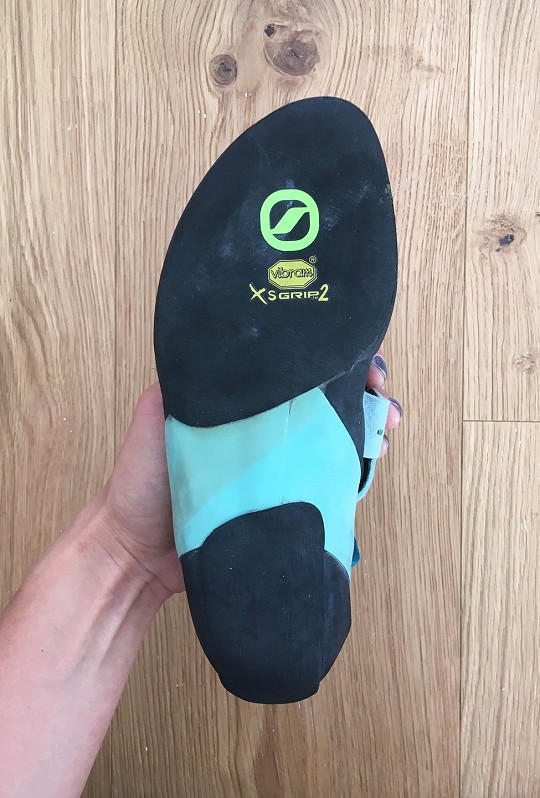
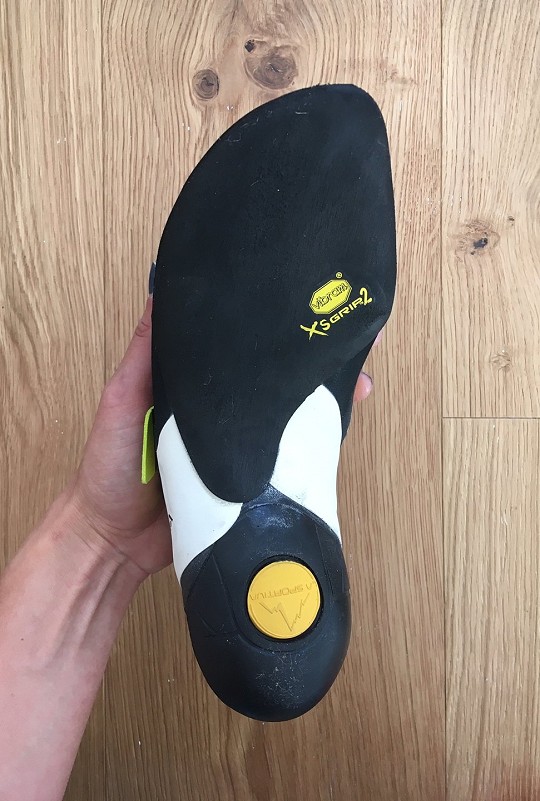
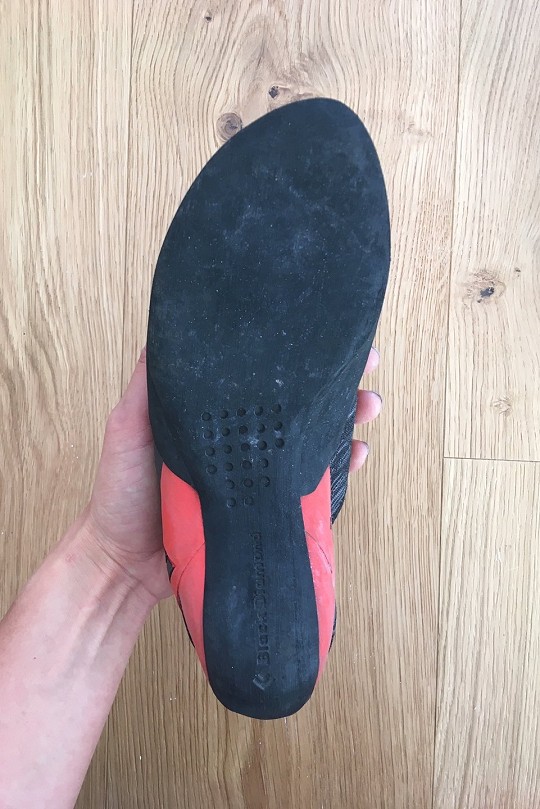
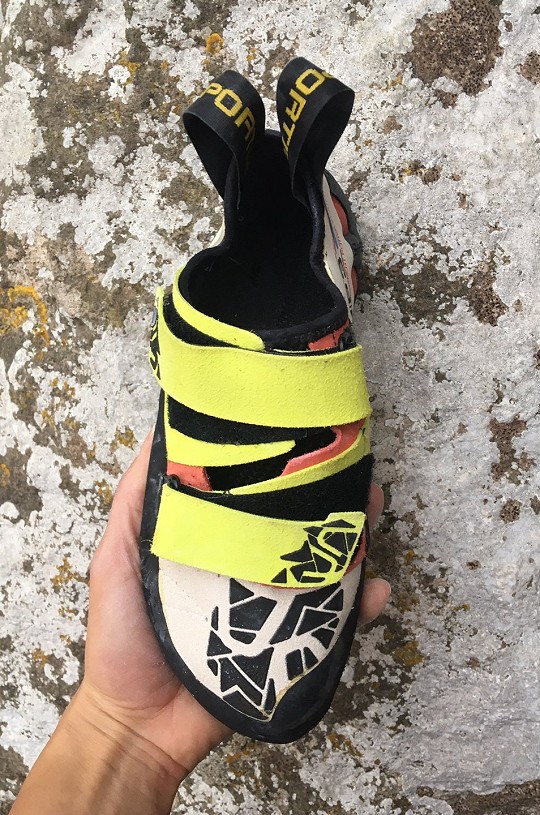
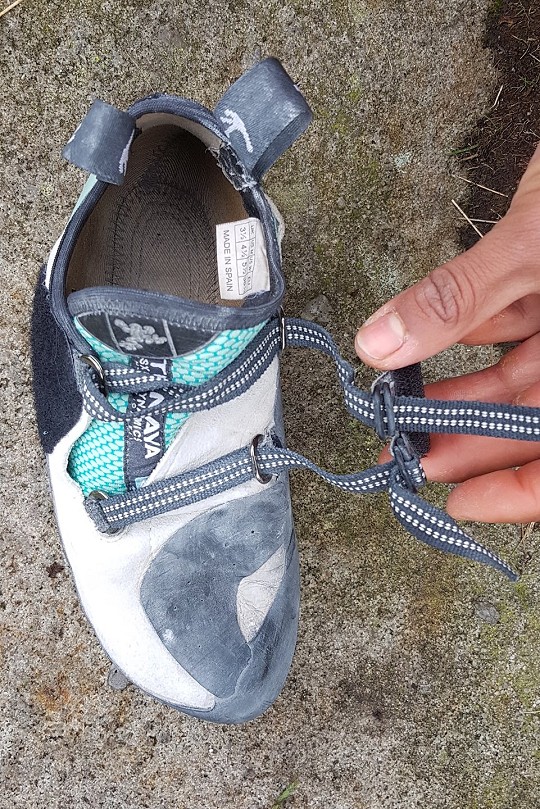
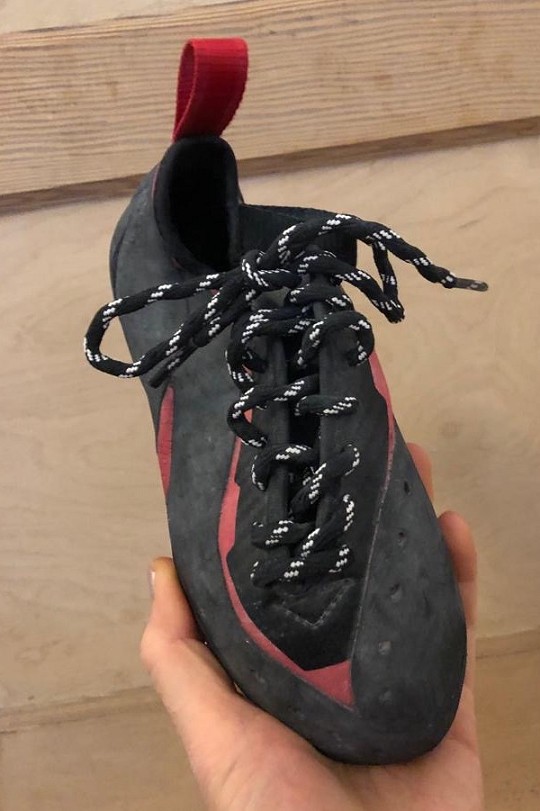
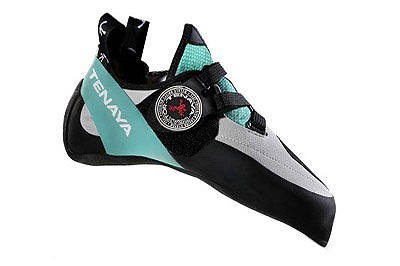


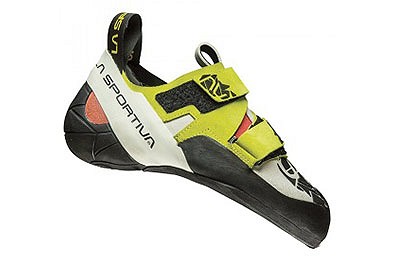
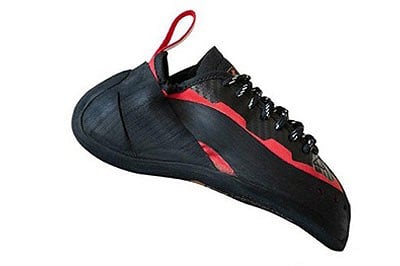





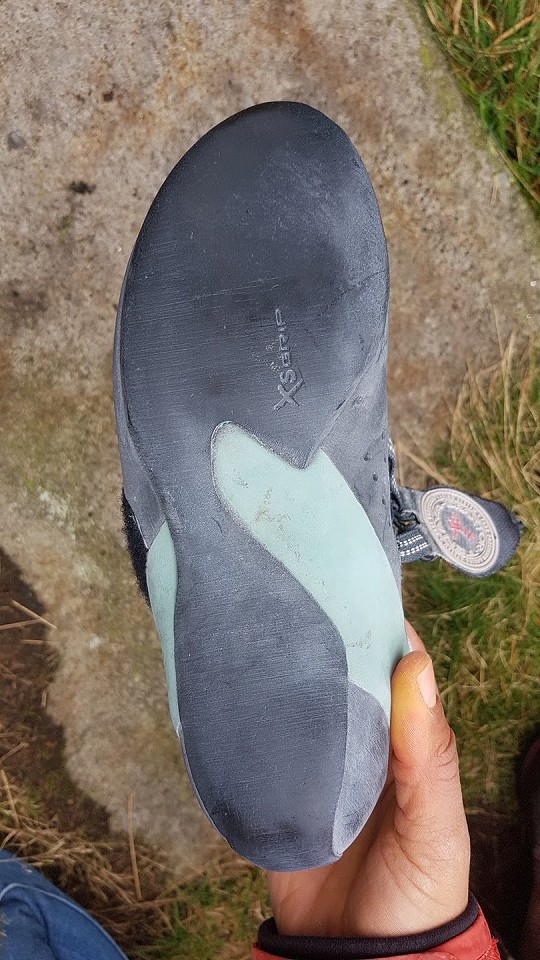
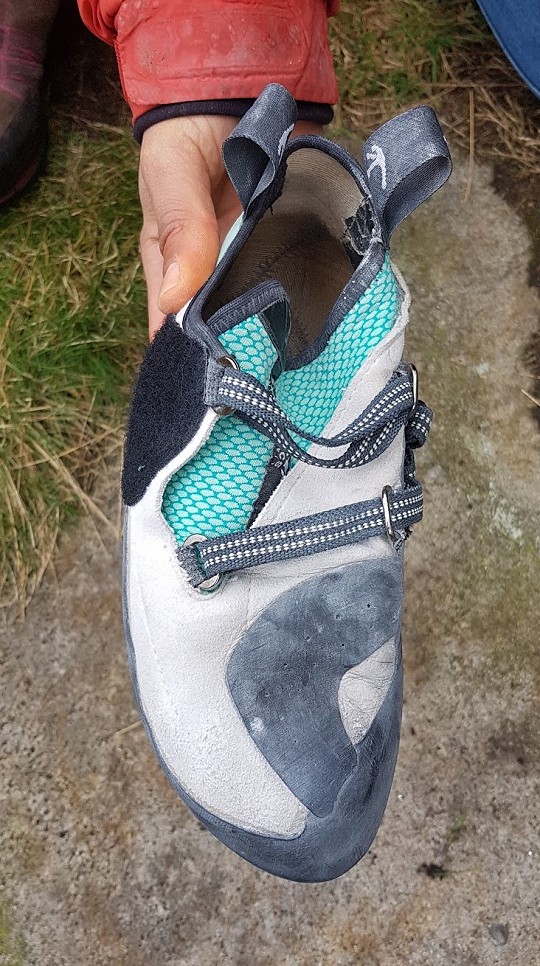
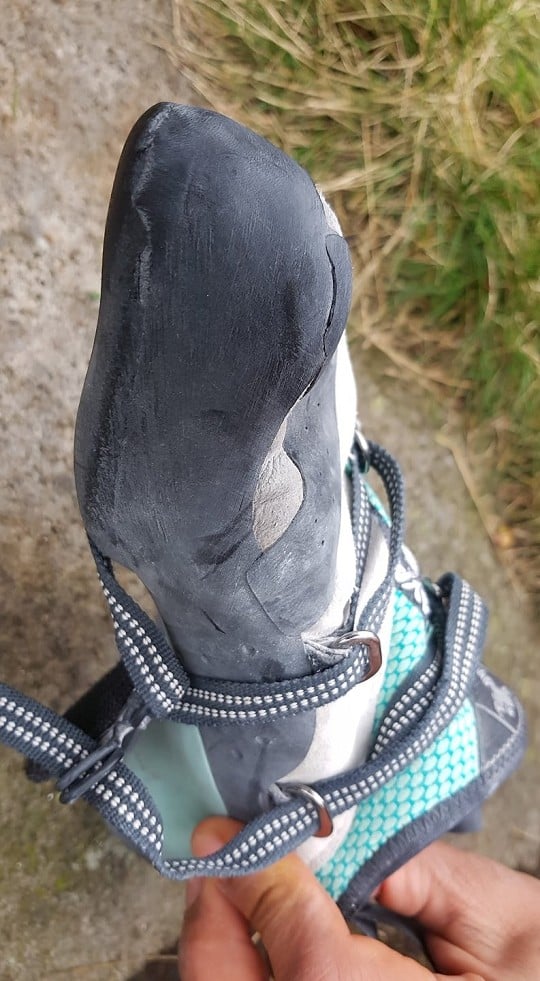


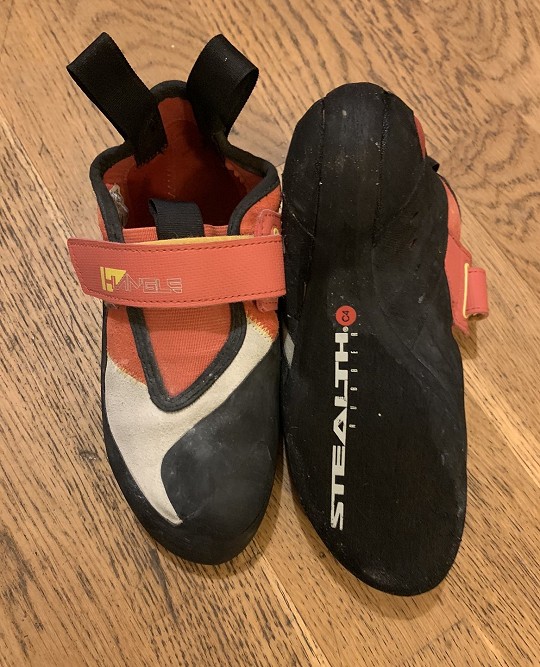
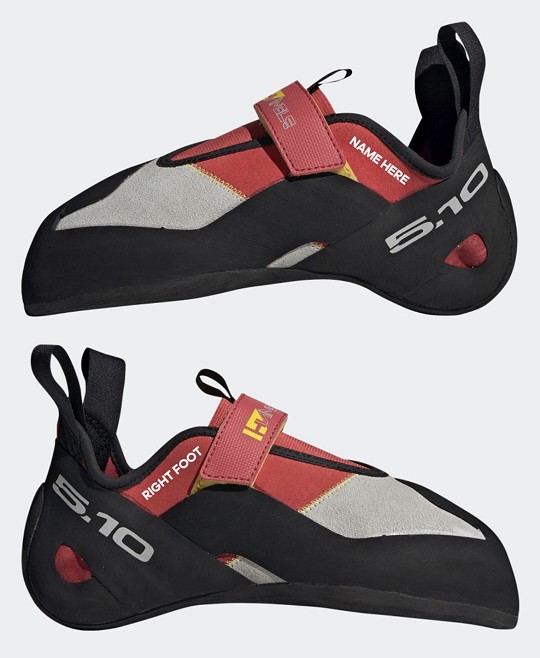
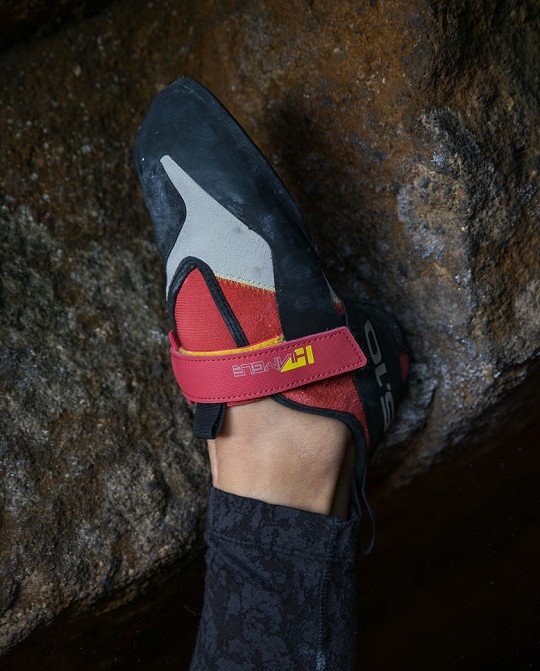



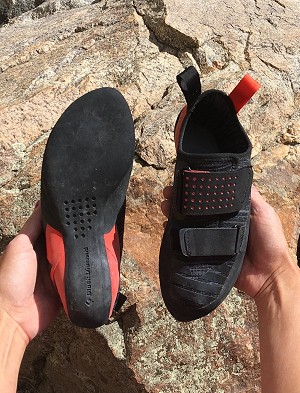

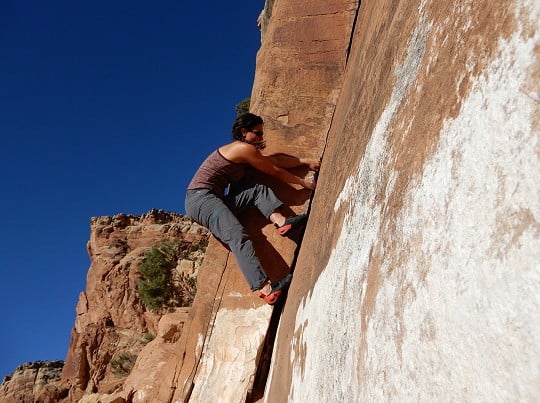
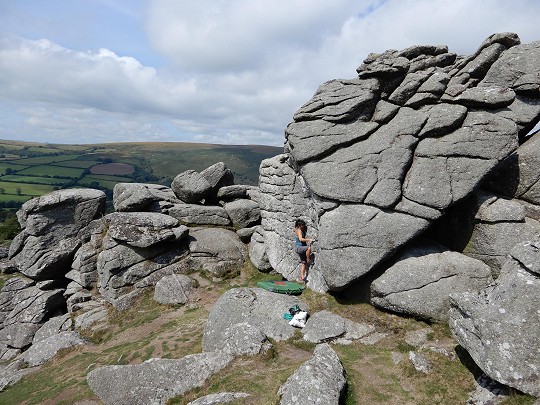

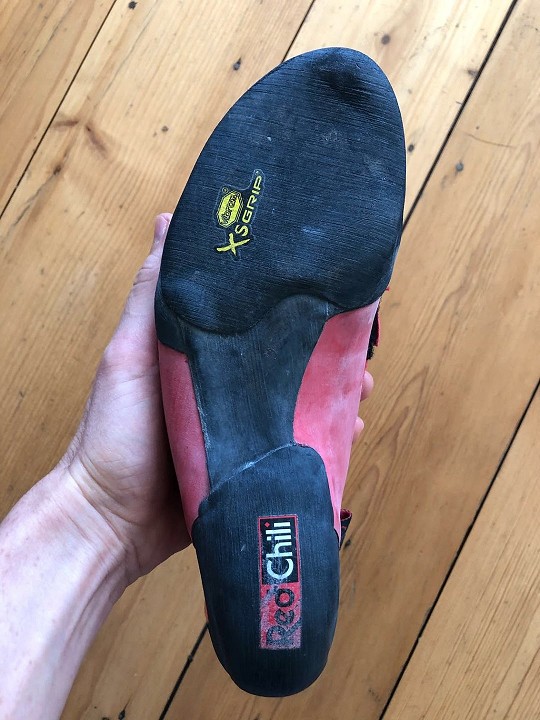
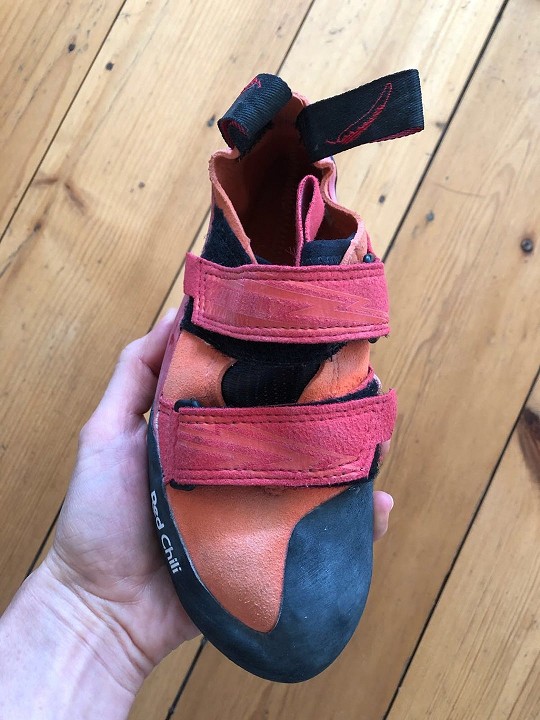
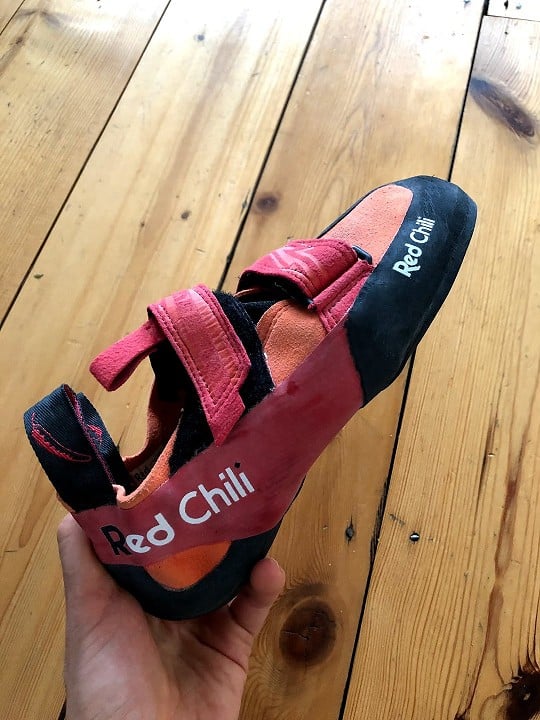
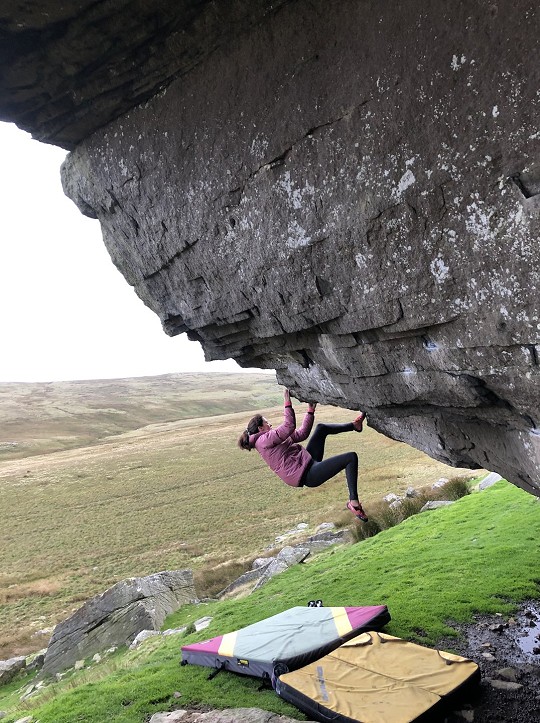
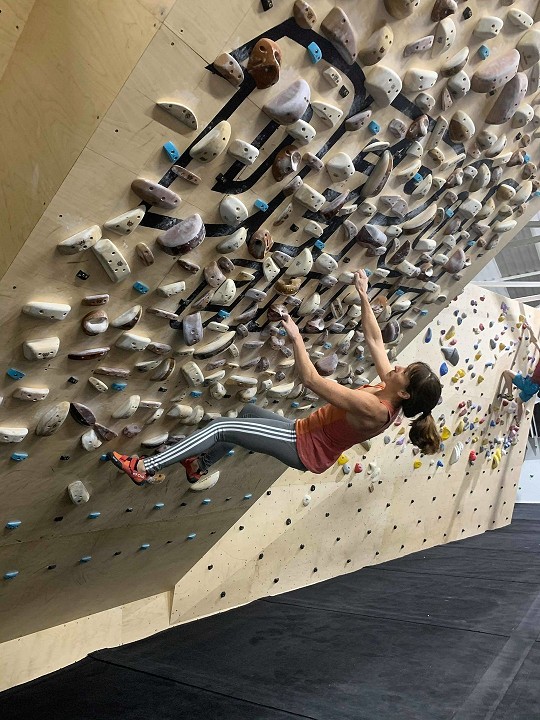

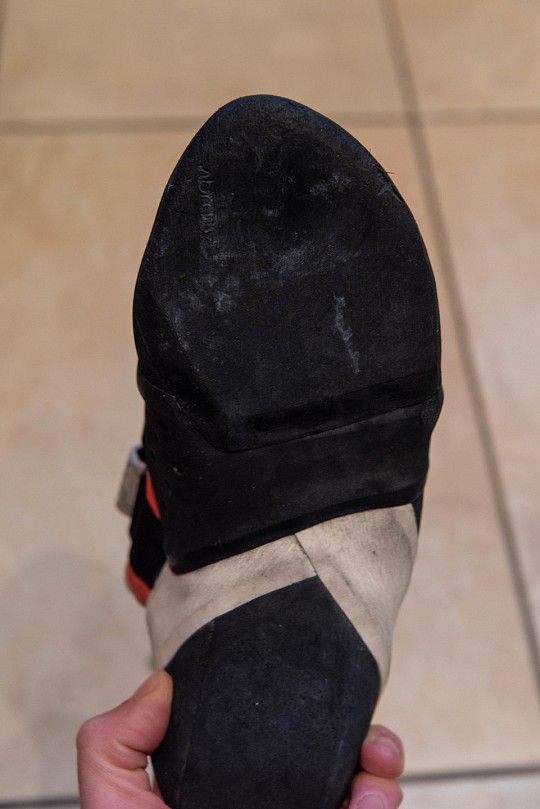
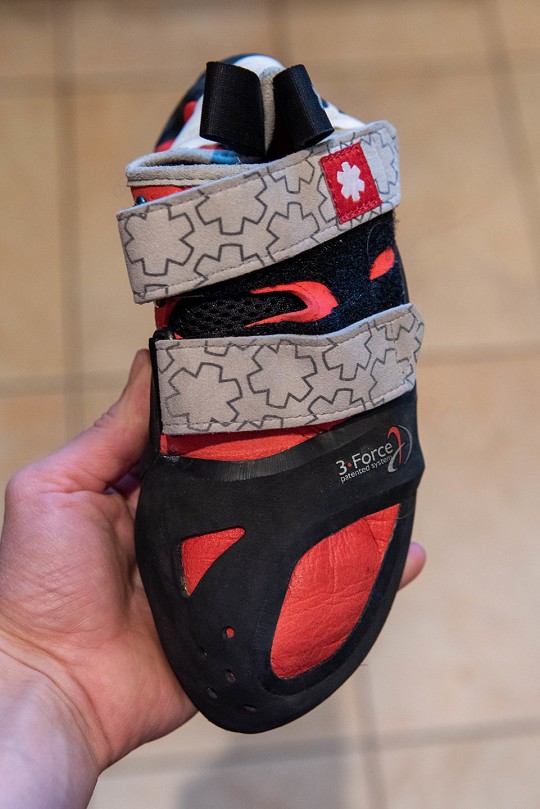
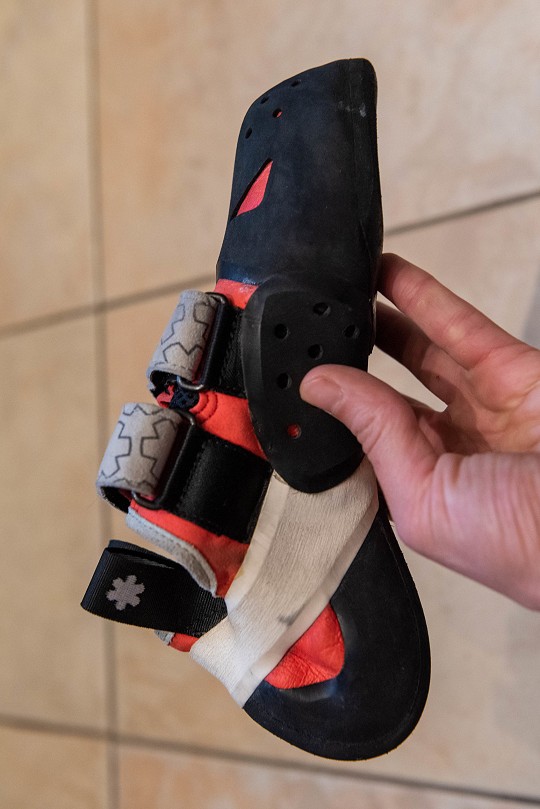

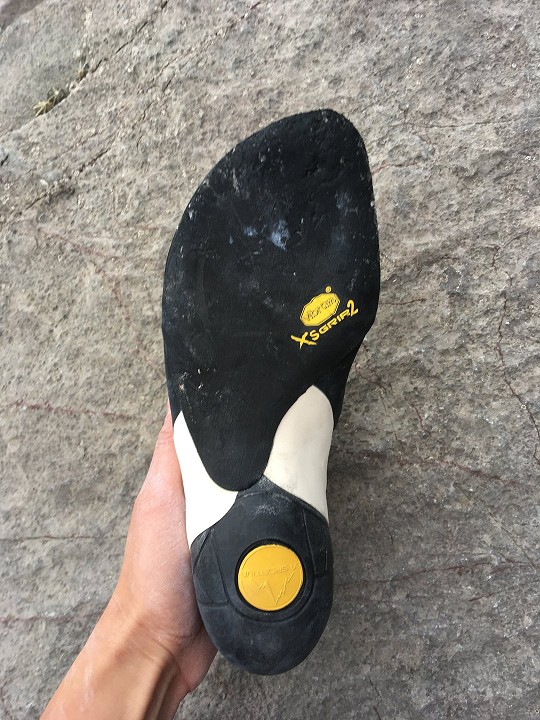
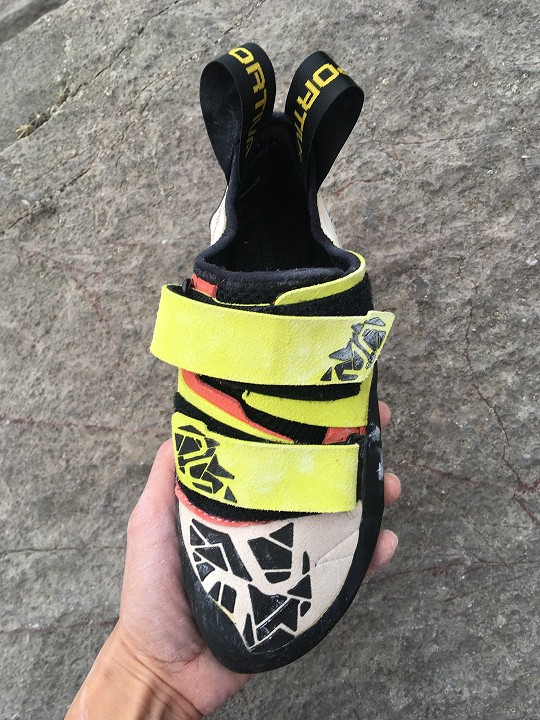
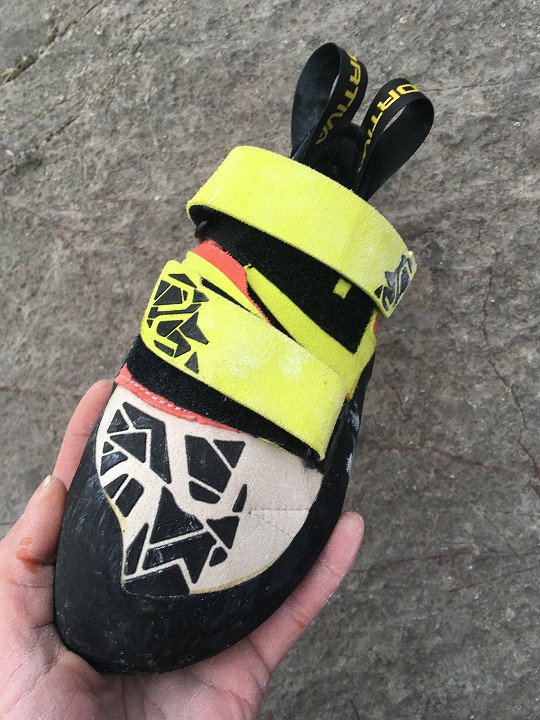
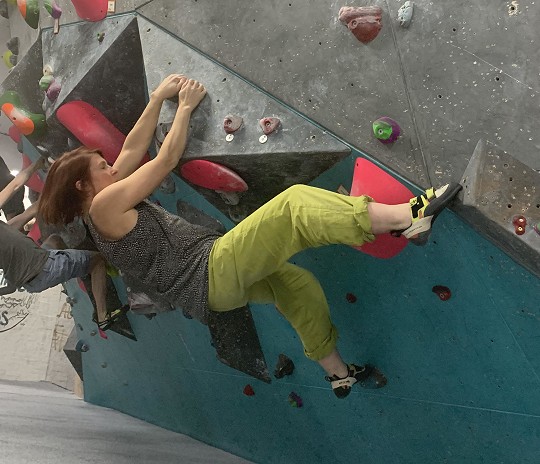
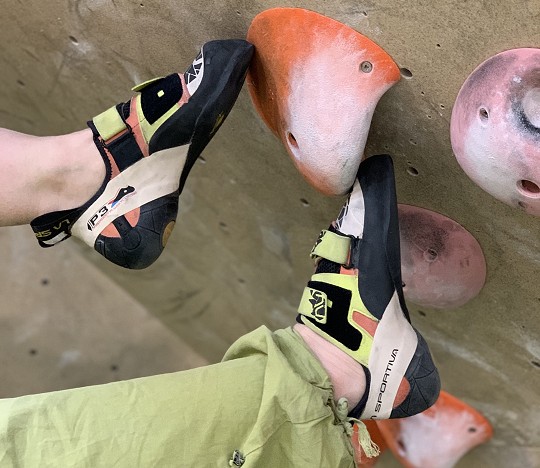


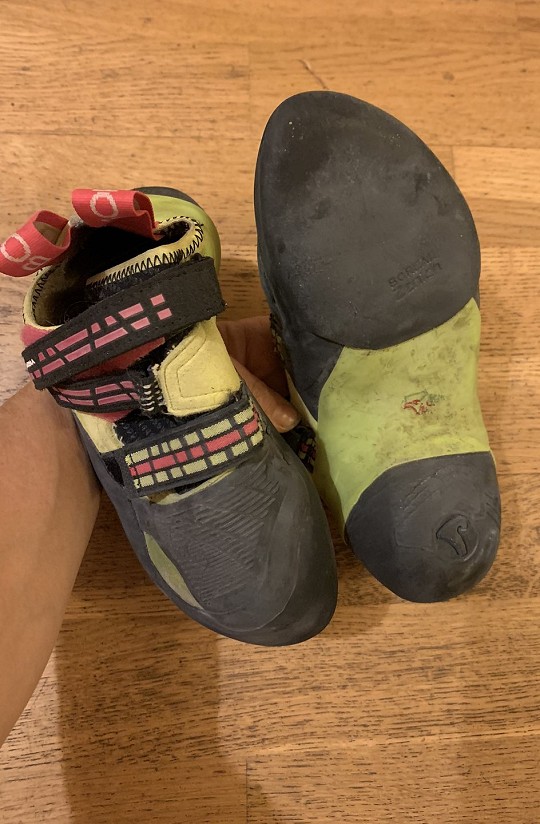
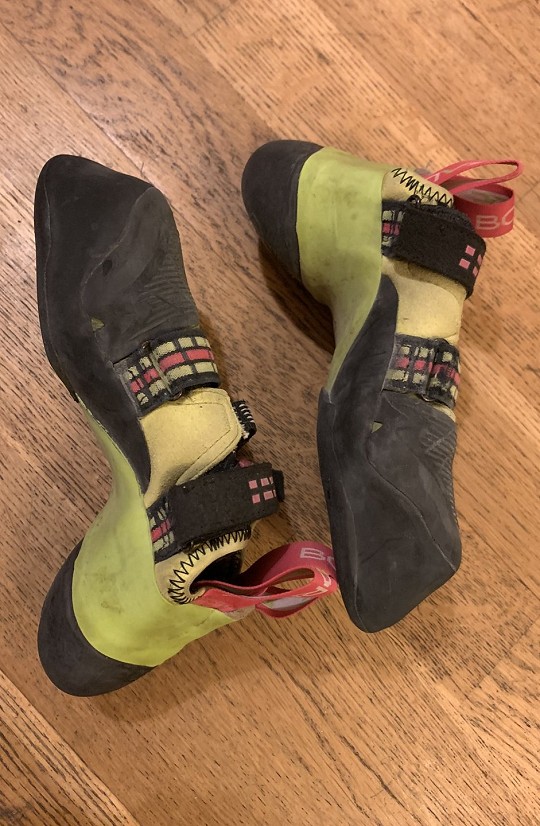
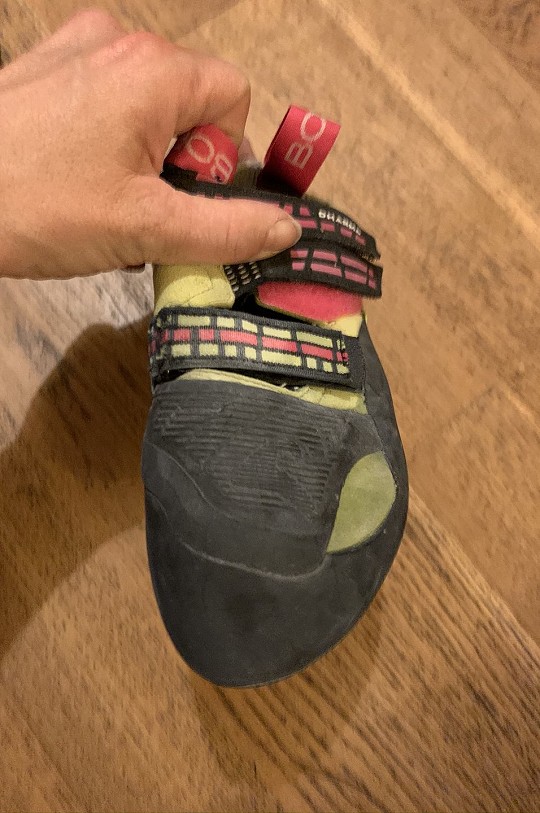
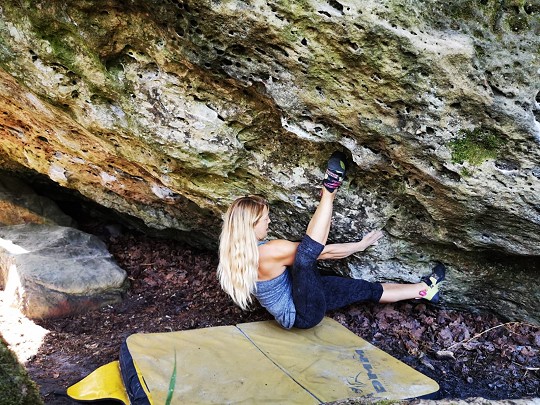
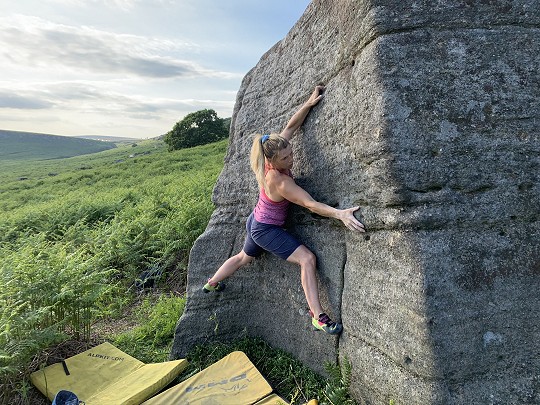

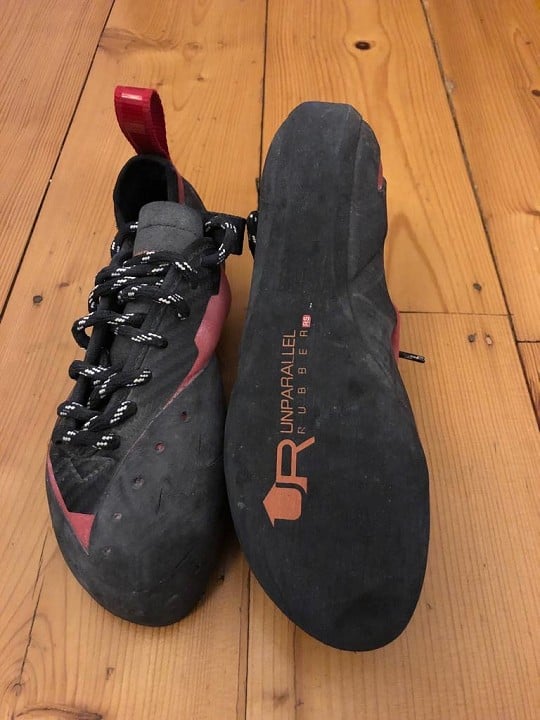
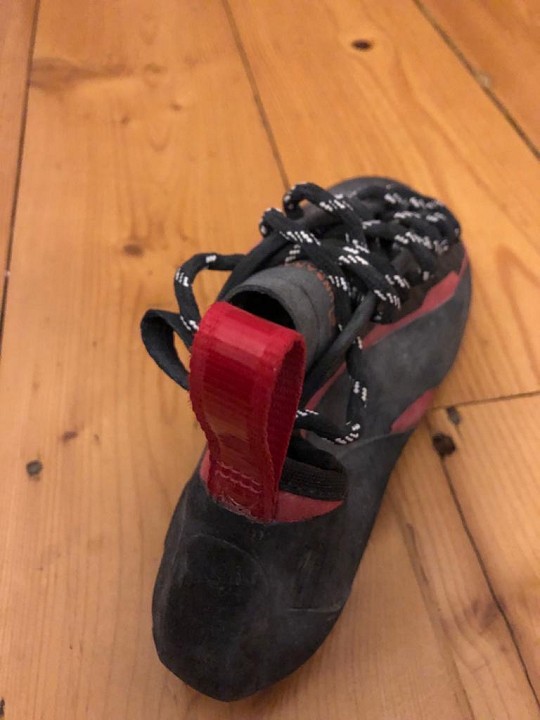
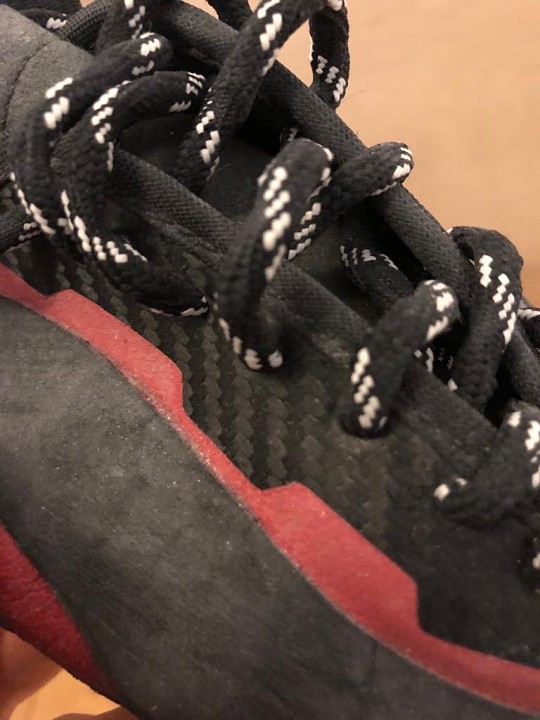
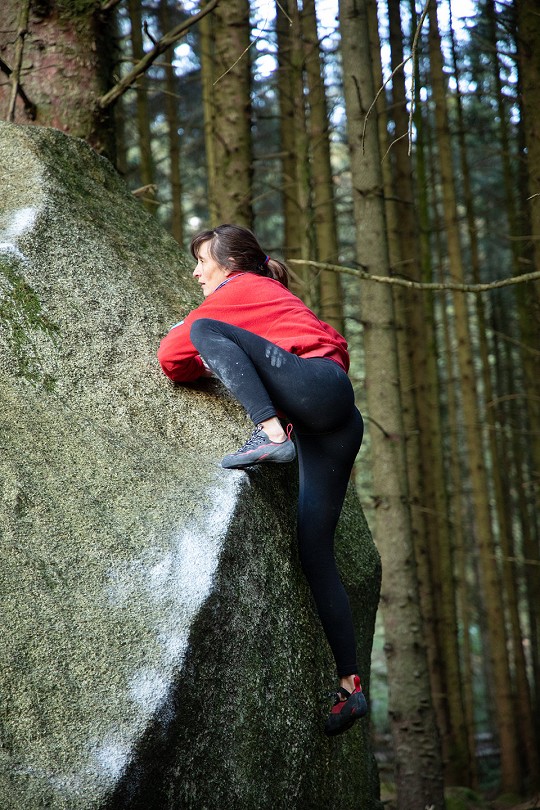
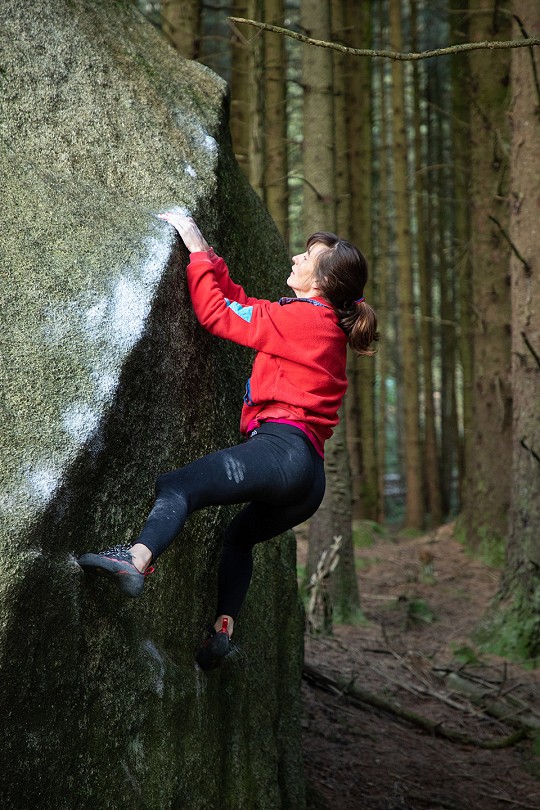
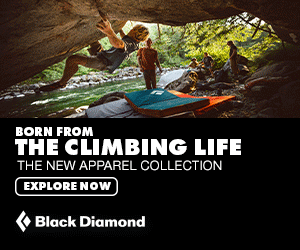
























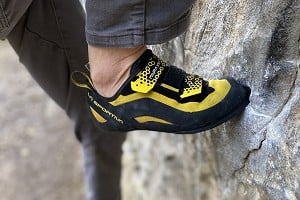
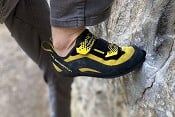
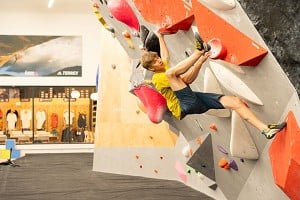
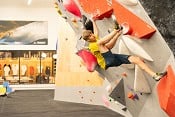
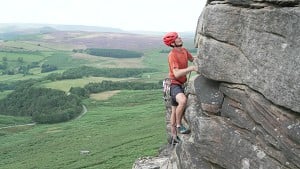

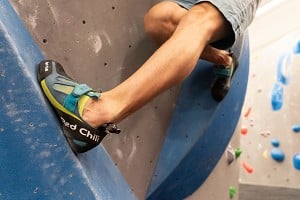
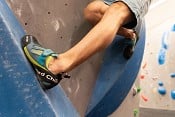
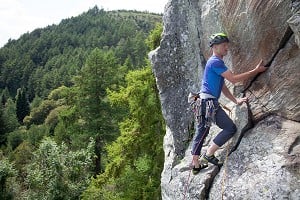
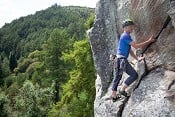

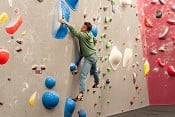
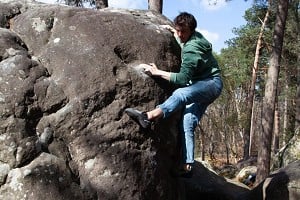
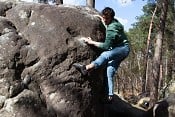
Comments